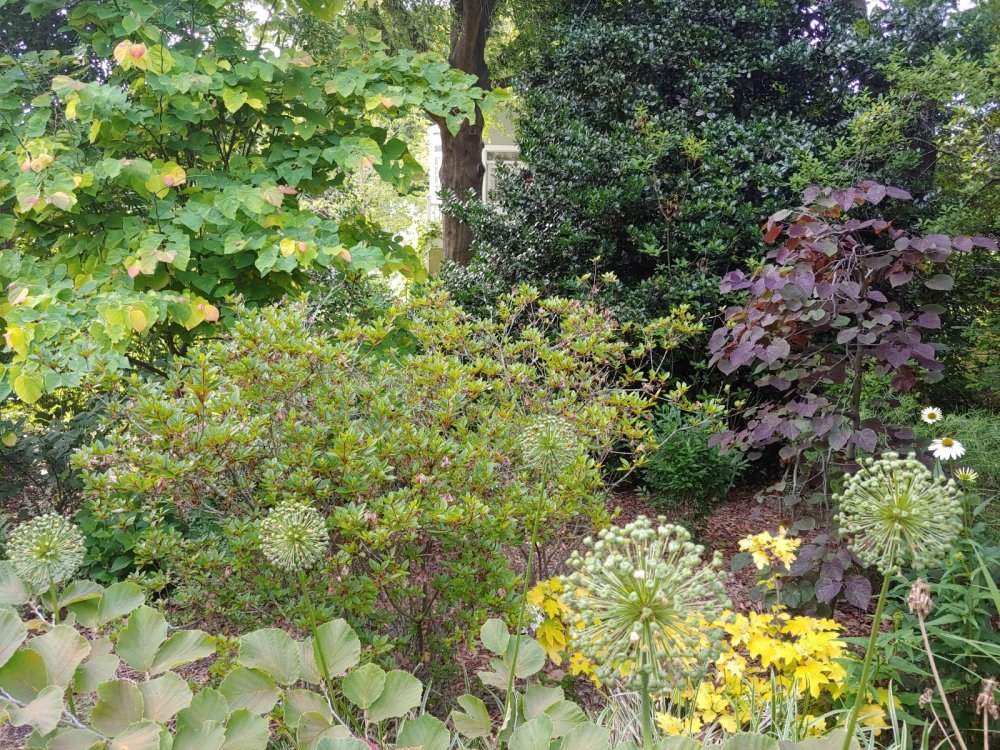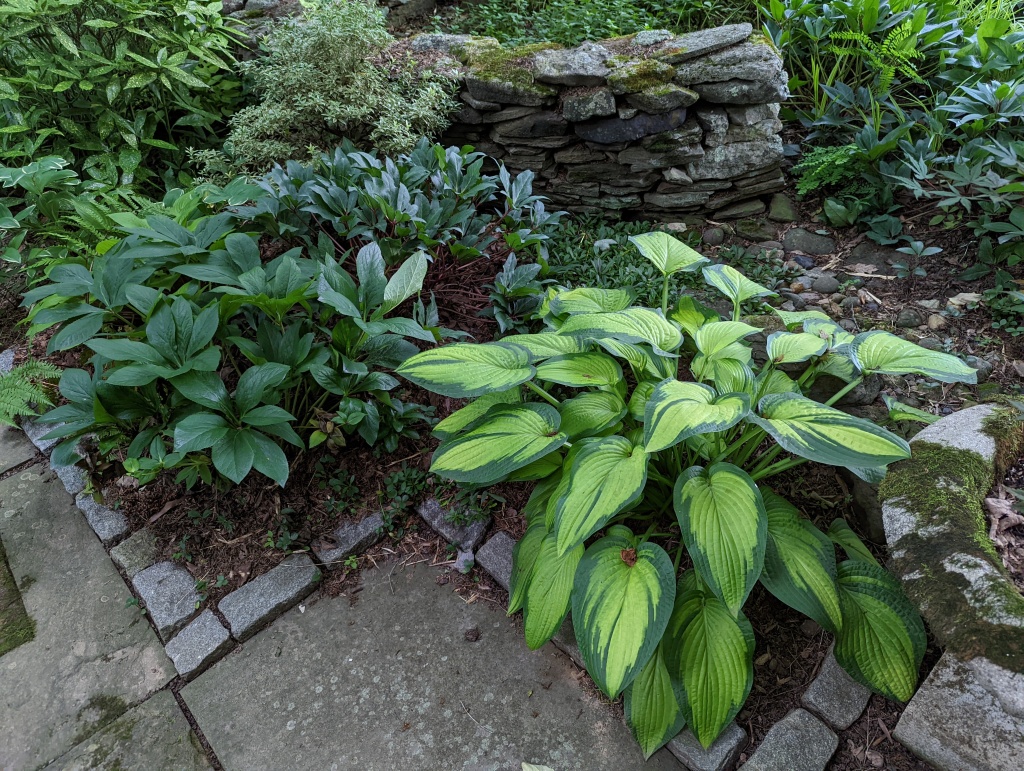The garden is not irrigated, and no way am I dragging hoses around when it turns dry, as certainly it will in summer. While new plantings are watched (often not carefully enough), everything else is expected to make it on the somewhat regular rainfall that comes once a week in this Virginia garden, though sometimes every other week. Yes, in summer it’s often a quick blast, but this can be just enough to maintain a minimum of ground moisture to keep everything alive.

The fading of lushness from summer heat and dry soil is often evident by mid-July, but I figure this is more about the heat and even irrigated gardens fade by mid-summer. I don’t worry a bit about the lawn. Already, clover is reclaiming area lost to fescues in their vigorous spring growth. The lovely, creeping Mazus reptans is gaining ground through damper areas of lawn, in particular in the lower, rear garden where granite stepping stones are spaced through a narrow area of grass (and weeds). I’m hopeful that mazus takes over the entire area shortly, but that’s likely to be a two or three year project.

While we’re on the topic of what I don’t do, I also do not fertilize, ever, and prune only when something strays too far over a path or into a neighbor. When I’m strolling the garden I’m likely to pull a few weeds, but my pruners are not strapped to my side. They’re not far away when needed, and without fertilizer or pruning to encourage soft growth, I suppose that less moisture is needed.

I’ve never paid any attention to drought tolerant plantings. I plant what I want, sometimes water after planting if a storm is not forecast, and that’s it. I try to pay attention to setting plants into their ideal situation, but that doesn’t always work out. Occasionally, the lack of attention is a problem for newcomers, but rarely, and if you look at the garden at the start of July you wouldn’t guess the lack of fertilizer or irrigation. You will quickly see the lack of pruning as ferns and shrubs arch over stone paths, but I’ll get around to that eventually.

No doubt, I look forward to thunderstorms on summer evenings. I’ll happily bring my evening in the garden to a close in exchange for a wave of storms. A week ago I barely made it indoors before the deluge, then watched as skies turned black and trees swayed violently in the storm. An hour later, as the neighborhood buzzed with chainsaws, it was fortunate that only branches were lost and not entire trees, and all that fell dropped harmlessly between prized trees and shrubs. A few perennials were squashed, but they’ll pop back quickly.

There are fewer flowers in the garden in summer, but at least for the next few weeks the lushness of late spring will carry over. Certainly, at some point (unless we have an abnormally wet summer) there will be a decline, but that’s expected, it’s summer.
So nice to hear that others in my area employ “tough love” for a thriving garden. When a plant or shrub/tree demands more attention, it gets moved to a more hospitable part of the garden. Occasionally I loose a carefully chosen plant but then move on.
While it is true that I sometimes neglect new plantings, more established plants do not require additional moisture or nutrition in this area with clay soil and regular rainfall. I am feeling neglected as recent storms have bypassed the garden.
Your garden is gorgeous. Thank you for saying you do not fertilize. That confirms to me that I need not fertilize either. I like the strategy of giving a great deal of thought, as to where to place new plantings initially in order to achieve success. Regarding the mazus, it is aggressively growing over my large stepping stones, covering them completely. I’m constantly having to rip it up like a rug, in order to see the stones. As for me, I wish I had never planted mazus in the first place. It’s pretty in the spring, with the carpet of blue flowers, but it’s taking over my yard and spreading into my grassy areas. I’m also still pulling up pachysandra that I planted 30 years ago.
I should also mention that I do not mulch, relying only on fallen leaves that provide cover for half the year until they decay and also nutrition as worms pull these into the soil.
I understand that mazus can be an aggravation, but anything green is good in the small sections of lawn.
I love my mazus. Hope it continues to spread. I can’t stop myself when a see a plant drooping from lack of water..I drag the hose out and at least give a few plants a good drink. I’m not sure I will ever stop that .
Here, the few hydrangeas in part sun regularly droop in late afternoon and perk up at sundown. My few hoses don’t stretch nearly enough to water anything but the pots on the deck, and this year most have turned to succulent gardens that I worry are too wet from rain.
Your information is very liberating for me. Although I do live on the high desert in Oregon where the summer rain is not as prevalent. I have many plants that get by on their own. We use a drip for some that can’t survive our hot, dry summer temps. I have pretty Daylillies that have survived and blossomed every year (over 30), a beautiful sage plant that flowers and gets pruned a lot for the spice. Hollyhocks that take care of themselves and delphinium that are VERY old and just keep blooming yearly. I have started a collection of Japanese maples. I never thought they would survive, but with a drip, they are doing fine. Also 4 paniculata hydrangeas and one smooth.
I really enjoy your posts, thank you.
I returned recently from a week in coastal Washington and Oregon admiring the gardens that depend on summer irrigation. It is much more of a challenge where you are. Despite writers who warn we must regularly be watering, pruning, and fertilizing, a garden can be much simpler than this.
Today is my first post, and if this appears twice, I beg forgiveness.
I truly look forward to your posts and pictures. You have inspired me in many instances to try new plants. Today’s picture of your stone path is just beautiful! Are the stones set in cement and mortar? I love the look of the rounded stones on the edges of your path. Did you use flagstone? We have invested quite a bit into hard scape, but as you venture out the paths are mulch lined; wood chips that we get from a nearby sawmill on route 7 near Leesburg. But as you know, eventually, I am pulling a zillion tree seedlings from the paths. Any advise or guidance is much appreciated. Thank you!
Early in the garden I did not have hard surfaced paths, but my wife says that mulch is mud, which is not exactly accurate, but it gets dragged into the house just the same. Since, I’ve been further disciplined to take off my outdoor shoes before going into the house. Occasionally, stuff falls off me anyway, but it’s much less than before.
Now, all paths are paved with various stones, but none are set into concrete or mortared. All were laid on graded soil and some on a shallow base of crushed stone, so some weeds do pop through. The path in the photo you refer to is made with basalt steppers (cut from basalt crystals, very hard) with river stones along the edges for a textural change. This path is slightly damp and partially shaded, so the gaps between stones are mostly filled by lichens that somewhat limit weeds. But, every time I walk through I pull a few.